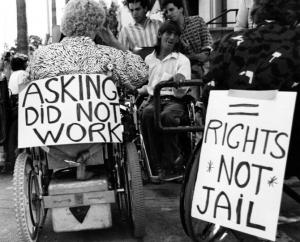Independent Living is for Everyone
People with disabilities should exercise control over their lives and live with dignity and self-determination.
The Americans with Disabilities Act (ADA) now requires that people with disabilities of all kinds—especially those with cognitive or intellectual disabilities—receive services in the “least restrictive environment.” This terminology both broadens the opportunities for people with disabilities in terms of living situation, employment, and education and alludes to the troubled history that helped fuel the ADA’s passage. For generations, society focused on what people with cognitive and intellectual disabilities couldn’t do, and viewed institutionalized care as necessary to“treat” disability. Institutions ran the gamut from rural, self-sustaining hospitals with farms and green spaces to crowded and unsanitary facilities with inhumane practices. Too often, people with disabilities were denied their basic humanity, separated from their communities, and shut away from our greater society. While all people with disabilities were historically viewed as less capable, those with cognitive and intellectual disabilities were often perceived as simply unable to make decisions or direct their lives in any capacity. For generations, these stereotypes led to a loss of control over one’s identity, environment, health, and overall life.
In the decades leading up to the ADA, people with disabilities, their families, and allies began to demand respect and autonomy for the disabled community. Advocates’ tireless efforts led to a crucial change in perspective, from thinking about disability as a deficit to identifying ways to help every person participate and achieve their goals. As University of Kansas professor Michael L. Wehmeyer notes about intellectual disability in particular, “the focus shifted from an intellectual disability being a problem within a person to looking at the interaction between the person and the environment in which that person wants to function and ways of enhancing personal capacity, modifying that environment and providing support.” The idea that we could change our communities and our environments to give everyone the chance to participate and succeed paved the way for the standards of the ADA, the Independent Living movement, and other inclusive approaches to take hold.
Today, the effects of the ADA, the growing Disability Pride movement, and the results of decades of advocacy and education mean that our society is much more accessible to people with disabilities. However, lingering misperceptions about people with intellectual and cognitive disabilities have meant that they are often among the last to benefit from these crucial movements. In fact, the landmark Olmstead decision, which resulted from a lawsuit by Lois Curtis contesting her long-term confinement in an institution against her will, was issued just 24 years ago in 1999, well after the ADA’s passage. This decision determined that “unjustified segregation and institutionalization of individuals with disabilities was a form of discrimination prohibited by the ADA,” and raised awareness of the continued institutionalization of people with intellectual and cognitive disabilities. A decade later, studies demonstrated that community-based care was not only more effective and empowering for people with disabilities, and also significantly less costly.
In 2006, the United Nations adopted the Convention on the Rights for Persons with Disabilities that called on partner nations to ensure access to the supports necessary for people to exercise their legal capacity, and for any safeguards or limits on a person’s legal capacity to take into account the person’s preferences and will, be proportional to their circumstances, and apply for the shortest period of time possible with routine review by an impartial body. These guidelines widely apply to people with intellectual disabilities, who are often subject to legal capacity limitations. Finally, in 2010, Rosa’s Law passed, changing references to “mental retardation” in U.S. laws and statutes to “intellectual disability” and helping to dispel stereotypes reinforced by derogatory diagnoses and labels. Organizations like MiSILC continue working to destigmatize intellectual and cognitive disabilities and promote full inclusion for all people with disabilities.
In spite of vast improvements in our society’s views of disability, people with intellectual and cognitive disabilities experience disparities in health care, employment, and housing even compared to others with disabilities, and are especially vulnerable to having their rights and autonomy unnecessarily compromised through guardianships or living arrangements. They are also more likely to be victims of crime or become involved with the criminal justice system, often as a result of lack of access to quality treatment. Finally, they are often underestimated, and therefore not provided the same opportunities to pursue independent, self-determined lives as other people. By raising awareness of what’s possible for people with a range of disabilities, we can dispel myths and better ensure that everyone has the chance to direct their lives and pursue their goals. At MiSILC, we continue striving to achieve access, inclusion, and independent living for every person, to recognize their unique potential, and to support them achieving independent living. To learn more, visit www.misilc.org
Tori Sullivan-Cortez
Michigan Statewide Independent Living Council
+1 313-644-2048
email us here
Visit us on social media:
Facebook
Instagram
TikTok
Legal Disclaimer:
EIN Presswire provides this news content "as is" without warranty of any kind. We do not accept any responsibility or liability for the accuracy, content, images, videos, licenses, completeness, legality, or reliability of the information contained in this article. If you have any complaints or copyright issues related to this article, kindly contact the author above.



